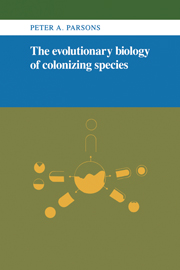Book contents
- Frontmatter
- Contents
- Preface
- 1 Introduction: Colonists and habitats
- 2 Genetics and ecology
- 3 Physical conditions, resources, and ecological phenotypes
- 4 Variability in natural populations
- 5 Genetic variability, ecological phenotypes, and stressful environments
- 6 Colonizing phenotypes and genotypes
- 7 Behavioral variability in natural populations
- 8 Habitat selection
- 9 The ecobehavioral phenotype: generalists and specialists
- 10 The ecobehavioral phenotype: biological control and domestication
- 11 Parasites and plants
- 12 Discussion and conclusions
- Appendix The study of quantitative traits
- References
- Index
10 - The ecobehavioral phenotype: biological control and domestication
Published online by Cambridge University Press: 15 September 2009
- Frontmatter
- Contents
- Preface
- 1 Introduction: Colonists and habitats
- 2 Genetics and ecology
- 3 Physical conditions, resources, and ecological phenotypes
- 4 Variability in natural populations
- 5 Genetic variability, ecological phenotypes, and stressful environments
- 6 Colonizing phenotypes and genotypes
- 7 Behavioral variability in natural populations
- 8 Habitat selection
- 9 The ecobehavioral phenotype: generalists and specialists
- 10 The ecobehavioral phenotype: biological control and domestication
- 11 Parasites and plants
- 12 Discussion and conclusions
- Appendix The study of quantitative traits
- References
- Index
Summary
Under domestication, we see much variability, caused, or at least excited, by changed conditions of life.
[Darwin, 1859, Chap. XV]It is remarkable that, in spite of the nonisotropy of the European area of diffusion with its many rivers, seas, and mountains, the process of spread of farming appears to have been relatively smooth and homogeneous.
[Cavalli-Sforza and Feldman, 1981:42]Chemical and biological control – hard and soft selection
Modern society has come to rely heavily on chemicals to control animal and plant pests, which are colonists that threaten people and their resources. The discovery of antibiotics led to cures of life-threatening infections and also eliminated the need for complex manual sterilizations of operating theaters and clinics. Although hospital costs were accordingly reduced, the microorganisms immediately adapted by the development of resistant strains from their survivors. Cavalli and Maccacaro (1952) described the consequence of such selection in the bacterium Escherichia coli using a regime where asexually reproducing colonies were plated on near-lethal levels of chloramphenical, so that selection can be regarded as being relatively hard. Those colonies surviving chloramphenicol did so because of a rare mutational event. In the absence of recombination, each new mutation was, therefore, tested on a particular genetic background that remained intact through subsequent (asexual) generations. Consequently in each selected line, the successful mutations may have conferred high resistance largely through their interactions with the rest of the genome. As long as asexual reproduction continued, these favorable epistatic interactions should persist. Accordingly, in sexual crosses, recombination disrupted these gene combinations that generated resistance, thus revealing that different lines had achieved resistance to chloramphenicol by different genetic routes.
- Type
- Chapter
- Information
- The Evolutionary Biology of Colonizing Species , pp. 175 - 190Publisher: Cambridge University PressPrint publication year: 1983



